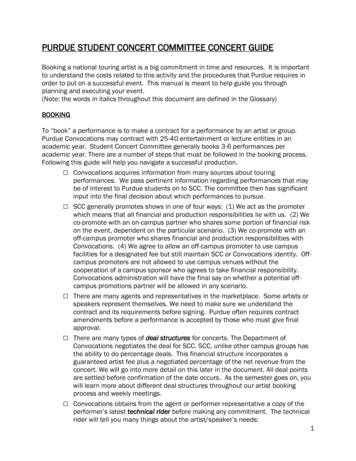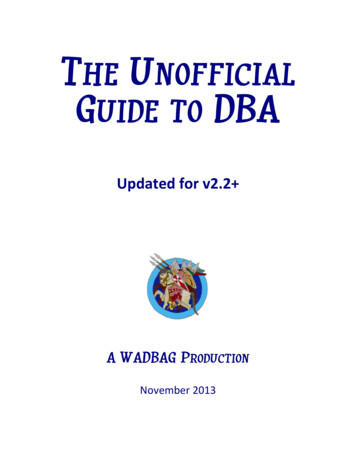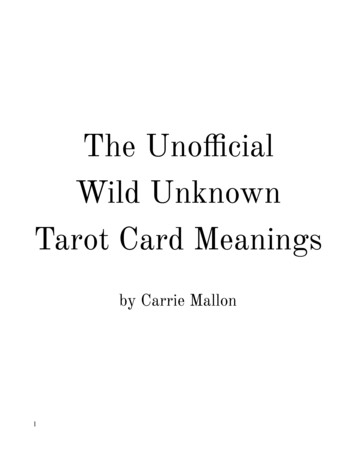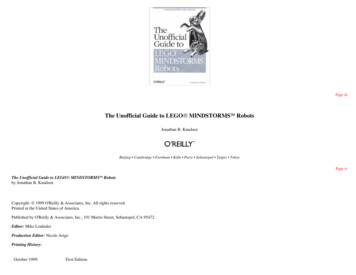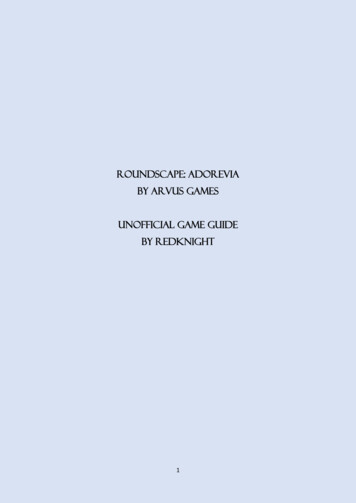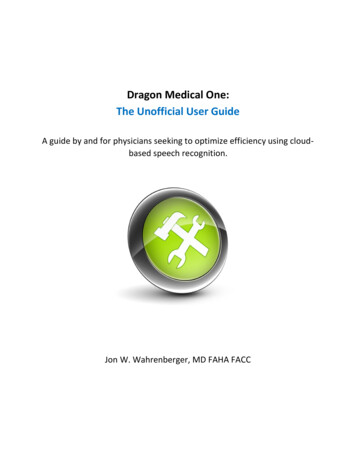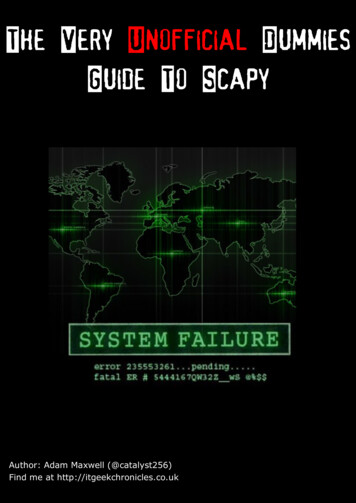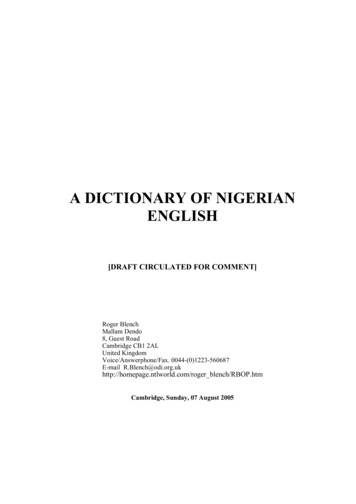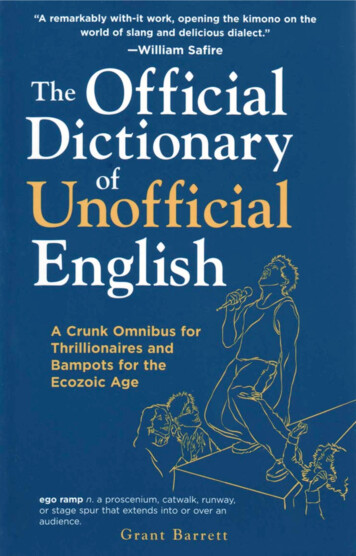
Transcription
TheOfficialDictionaryofUnofficialEnglishA Crunk Omnibus for Thrillionairesand Bampots for the Ecozoic AgeGrant Barrett
Copyright 2006 by Grant Barrett. All rights reserved.Manufactured in the United States of America. Except as permitted under the UnitedStates Copyright Act of 1976, no part of this publication may be reproduced orditributed in any form or by any means, or stored in a database or retrieval system,without the prior written permission of the publisher.0-07-149163-5The material in this eBook also appears in the print version of this title: 0-07-145804-2.All trademarks are trademarks of their respective owners. Rather than put a trademarksymbol after every occurrence of a trademarked name, we use names in an editorialfashion only, and to the benefit of the trademark owner, with no intention of infringement of the trademark. Where such designations appear in this book, they have beenprinted with initial caps.ABOUT THE AUTHORGrant Barrett is an American lexicographer and dictionary editor specializing in slangand new words. He is part of the team of lexicographers that make the newonline dictionary Wordnik.com possible. Grant is also co-host of the American languagerelated public radio show "A Way With Words" http://www.waywordradio.org andeditor of the "Oxford Dictionary of American Political Slang" (2004, Oxford UniversityPress), and is well-known for his prize-winning online Double-Tongued Dictionary. Besidesbeing a widely quoted language authority, Grant has written on language for such newspapersas the Washington Post and the New York Times, has contributed to the British book series"The Language Report," and is a public speaker about dictionaries and slang. He also writesa fortnightly column about English-language slang for the Malaysia Star, a bi-monthlydictionary update for the journal Copyediting, and has worked as a business and musicjournalist. He serves as vice president of the American Dialect Society, an academicorganization devoted since 1889 to the study of English in North America. He also is chairof its New Words Committee, edits the "Among the New Words" column of the society'sjournal American Speech, is a member of the journal's editorial review board, and helpsorganize the society's annual "word of the year" vote. He is also a member of the DictionarySociety of North America and the Linguistic Society of America.
ContentsAcknowledgmentsivIntroductionvAbout This DictionaryxiiChanging EnglishxviiiDictionary1Select Bibliography407Full-Text Digital Resources410For Further Information411iii
AcknowledgmentsThanks to Erin McKean for her guidance, wisdom, and humor, andto Jonathan Lighter for demonstrating worthy models of both lexicography and a lexicographer. Special thanks to Laurence Urdangand the Dictionary Society of North America for their grant in support of my web site. For their suggestions, corrections, additions,notes, comments, and other help, thanks also are deserved by Gustavo Arellano, Nathan Bierma, Bill Brogdon, David Barnhart, Carlos Caga-anan II, Hunter Cutting, Jamie Davis, Paul Deppler, SteveDodson, Connie Eble, Cathy Giffi, Yesenia Gutierrez, SonyaKolowrat, Margaret Marks, Yisrael Medad, Bill Mullins, JohnnyNorth, Mark Peters, Barry Popik, James Proctor, Michael Quinion,William Safire, Strawberry Saroyan, Jesse Sheidlower, Ava Swartz,Michael Volf, Steven I. Weiss, Douglas Wilson, David Wilton, BenZimmer, the online communities at Languagehat.com and WordOrigins.org, and everyone on ADS-L, the American Dialect Society e-mail list. You all make it easier.iv
IntroductionThis book is the result of hunting on the Internet for unrecordedwords. In these pages, you’ll find words you’ve never seen before—even though they’ve been around for decades. You’ll find old wordswith new definitions. You’ll find foreign words tiptoeing into foreign Englishes, sports jargon butting into politics, street slangbouncing out of California, and Spanish moving comfortably intomainstream American English. From dozens of countries, from politics and sports, slang and jargon, humdrum to extraordinary, newand old, what you’ll read is language that deserves a little moreattention.Although it may look like it at first glance, not all of these wordsare new. Many are, but more than a few have histories spanningdecades or even a century. They all share, however, two characteristics. One, they are undocumented or underdocumented. Thismeans that there is more to be said about them than has so farappeared in other dictionaries. Two, they are interesting in and ofthemselves, either as cultural artifacts, for their history, or evenjust for the way they roll off the tongue.The Why of the Word HuntEarly in 1999 I began a Web blog called World New York. The website’s primary focus was New York City and things of interest to itsinhabitants. I developed a series of complex Web searches that dugdeep into the Internet and pulled out the new, the unusual, the pithy,and the funny and then posted them as extracts and links. In acasual fashion I also began recording interesting words as I cameacross them, presenting them mostly as curiosities. Because myreaders sent messages saying they liked the interesting words, I spentextra time hunting them down. I soon realized that there were manyzillions of useful and interesting words to be found if I looked hardenough and in the right way. But I also saw there was more to bedone than I had the time for because there were many lexical itemsthat seemed to be uncollected by anyone—at least, they didn’tappear in any of the dozens of dictionaries I owned.v
IntroductionSo in June 2004 I turned my blog into a dictionary-orientedweb site, which I named Double-Tongued Word Wrester (doubletongued.org). It is what I call “a growing dictionary of old and newwords from the fringes of English.” With the goal of reaching intothose uncharted waters and hooking the so-far uncaptured words,I began to think about the best way to collect the uncollected, torecord the unrecorded, to document the undocumented and theunderdocumented.The How of the Word HuntWhen compiling dictionaries, there are two primary tasks. The firstis identifying lexical items, be they new words or new meaningsfor old words. The second is substantiating lexical items: provingwhere they come from, what they mean, and how they are used.Defining TermsThroughout this book, I use lexical item to mean anything that isto be defined, be it a single word, phrase, term, or affix, includingprefixes, suffixes, and infixes (syllables that are inserted into themiddle of other words). I’ll also use the term reader. In lexicography, a reader is someone who reads in an organized, consistent fashion with the intent of discovering new lexical items that warrantrecording. When a lexical item is first found but not yet substantiated as a definable term, it is a catchword.How the Corporations Do ItMost modern dictionary publishers of any size have archives, bothpaper and digital, of citations that have been collected by readerson the prowl for new language. Large dictionary operations, likethat of the Oxford English Dictionary (OED), have many paid andvolunteer readers who can return thousands of new citations everyyear. Readers are usually assigned specific publications (includingruns of periodicals) to read their way through. Each time they findsomething that strikes them as new, noteworthy, or worth investigation, they cite it. The results of this work can be substantial—editors at Merriam-Webster have more than sixteen million citations on paper. These citations include the catchword, the source(book, newspaper, transcript, etc.), the date, the author, who saidvi
Introductionor wrote it, and an exact quote of the words used. A few notes mightbe added to a citation to indicate a context or connotation thatmight not be immediately clear.Once it’s time to edit a particular part of a dictionary, the citation slips (or database records) are gathered. If there are, for example, a dozen slips for crunk, then a draft entry can immediately bewritten. New research is then done to further substantiate the wordor to trace its origins. Words for which there is only a single citation slip get a more thorough investigation. Readers are sent to lookat specific books, or to peruse the works of specific authors, or tomake inquiries into journals on specific subjects, all in the hope ofproving that a single citation represents a valid, recordable lexicalitem that deserves an entry in a dictionary.In the past twenty or so years, this work of substantiating termshas grown easier. First with the appearance of digital databases suchas Lexis Nexis, Dialog, and Westlaw, and now with the addition ofothers such as Proquest Historical Newspapers (and Proquest’sAmerican Periodical Series), NewspaperArchive.com, Dow JonesFactiva, Google’s twenty-five-year archive of Usenet posts, the twoMaking of America databases at the University of Michigan andCornell University, and many others. It’s easy to spend a few minutes searching for a lexical item to find out if it has been used, bywhom, and what the user intended it to mean. Particularly for recentlexical items, etymological work has never been easier.Individuals unaffiliated with dictionary publishers, like a number of pro-am volunteers associated with the American Dialect Society, do this sort of history-hunting purely for the thrill of the huntand can, in a matter of minutes, destroy longstanding theories onword origins, develop new possible etymologies, expand the understanding of new meanings for old words, and antedate lexical itemsby days or decades. As new databases come online and as thousandsof new digitized pages are added to the existing databases, there isalways new digital digging to be done. A much-anticipated newspaper digitization effort was announced by the National Endowment for the Humanities and the Library of Congress in 2004. Itwill preserve millions of periodical pages from 1836 to 1923 insearchable online archives.But this sort of research only revolutionizes the second primarytask of dictionary-making, the substantiation—the proving, vetting,vii
Introductionand testing—of found words. The first task, identifying previouslyunrecorded lexical items, is still relatively complex.Besides reading programs like the OED’s, dictionary publishersand third-party consortiums now develop corpora made up of hundreds of millions of words pulled from books, periodicals, conversation and media transcripts, and elsewhere. Specialized toolsanalyze them, looking for unique, new, or unusual patterns, associations, or usages. This brute force method, while effective, is alsotime-consuming, costly, and labor-intensive. It also requires specialized technical knowledge in a field where time, money, andmanpower are often in short supply. Certainly this method, like areading program, is probably inappropriate for a small dictionarymaking operation, and definitely out of reach for a simple web sitecreated for the joy of revealing interesting language.What can a small operation—or a solitary lexicographer orword freak—do to participate in the hunt? As it turns out, quite alot.Wayne Glowka, with the help of others, is the latest neologianto collect new words for the “Among the New Words” column inthe professional journal American Speech, a column that has beenpublished for more than fifty years. William Safire, with the helpof a series of able assistants and his readers, has been discussing newand novel language in a syndicated weekly column for more thantwenty years, on top of writing political commentary and books(including at least one political thriller). He is probably the mostrecognized writer on language in the United States. David Barnhart(of the famous Barnhart dictionary-making family) has been a partof publishing the quarterly Barnhart Dictionary Companion since1982, in which he brings his word finds to the attention of subscribers. Paul McFedries’s Word Spy (wordspy.com), Evan Morris’sWord Detective (word-detective.com), and Michael Quinion’sWorld Wide Words (worldwidewords.org) are three web sites thatexploit their creators’ penchants for constantly monitoring languagechange; all three solo word hunters have also turned out books.Given those models of mostly solitary word-hunting, it’s clearthat keeping an eye on the malleability of English discourse doesn’trequire large budgets or manpower.viii
IntroductionTracking and Capturing the Wild JournalistOne of the characteristics shared by the best word hunters, bothprofessional and amateur, is erudition. That is, they tend to be welleducated (even if that education is autodidactic), literate, and, therefore, thoroughly at home with the printed word.In looking through the citations I had casually gathered formy old Web blog, I noticed a curious pattern: writers are predictable.Journalists—the source of most of my interesting words—have atendency to flag words that are new to their vocabulary with suchphrases as “known in military parlance as” or “referred to as” or “asthey call it” or “known to fans as” or even the straightforward“coined the word” or even just “new word.”This means that journalists as a body are giving tips on newwords to anyone who cares to pay attention. They’re like accidental participants in a worldwide dictionary reading program, creating texts right and left that they sprinkle with found words fromtheir daily interviews, research, and conversations. Therefore, whenthey introduce a new word with a phrase like “called in copspeak,”it behooves the word-hunter to pay attention.Thus, with the aforementioned digital databases (and manyothers) it’s easy to search for these collocations—that is, to lookfor the juxtaposition of the identifying phrases such as “called bymany” or “referred to as”—and then read nearby text to see if thereis a word worth turning into a citation slip—not all that far off fromthe searching I did when looking for newsworthy bits about NewYork City for the old Web log.Reading all these news stories is still time-consuming, but thereare still other shortcuts. In order to speed the word-hunting, services such as Google News permit collocation searches to be automated. As of this writing Google News indexes more than 4,500English-language periodicals and news-oriented web sites that publish on the World Wide Web. At no cost to the user, it permits thecreation of automated alerts that conduct searches in real time andthen delivers the results via an e-mail alert when there’s a match.It turned out to be just the ticket for finding interesting newlexical items for the Double-Tongued Word Wrester web site. Currently, with more than 800 collocations being searched, hundredsix
Introductionof e-mail messages arrive in my inbox daily, each of them containingat least one potentially citable lexical item. Google News also permits searches in foreign languages, so unique phrases in French,English, and other languages likely to lend or borrow from Englishcan be searched for, too—phrases such as “jargon anglais” or“espanglish.”Although I have collected thousands of citations in this waysince 2004, this method is far from perfect. For one thing, thereare plenty of journalists who are culturally left behind, the kind offolks who are just now commenting on the novelty of “bling bling”even though it’s a word that has spread far since B.G. and the CashMoney Millionaires made it a household word in 1999. It’s so common, in fact, that it’s also now appearing in overseas Spanish as “blinblin.” These are the same journalists for whom the word “blog” isa novelty. Coined in 1999, I still regularly come across opinionpieces commenting on this newfangled “blog” thingy. Some journalists are on the cutting edge; some are still struggling to get outof the silverware drawer. This means that more than a few of thesearch results will be dead ends.That’s not a criticism of the journalism profession so much asit’s an ordinary truth about all language speakers. Most words arenew to most people most of the time. But most “newish” words thatfloat about in the zeitgeist for any reasonable length of time willeventually come up using these collocation searches—even if it isfive years later. Whenever they are encountered, whether they arebrand-new or old hat, the most important thing is to get them onthe record so they can begin the substantiation process.In this way words that seem perfectly ordinary—like huck ‘tomake a short toss’ or heartsink ‘dismay or disappointment’—cancome to light. These terms were undocumented, as of this writing,in any of the hundreds of dictionaries, major and minor, that I nowown or have access to.It’s not just newspapers that can be searched this way. Onlineservices such as Feedster, Technorati, Daypop, and PubSub also permit automated searching of material produced by nonjournalistswho write on everyday subjects in Web logs, journals, and other personal sites. While blogs return far fewer good hits for each thousand search results than do newspapers—mainly because nonjournalist writers tend to be less formulaic than journalists and usex
Introductionless-common collocations or no collocations at all, but also becausethe education and age range skews much lower for run-of-the-millpersonal web sites—blogs have the advantage of returning far moreslang and nonstandard language. In English alone there are moreblogs, covering more topics, from more places, written by more people, than there are newspapers published in the entire world in anylanguage. This means the possibilities for new lexical items bubbling to the surface are immense.A bonus of word-hunting by looking for journalistic flags isimmediacy. Not only can new or newly popular terms be identified by lexicographers very soon after they bubble to the surface,but they can be captured before periodicals archive their online content in fee-based archives. Automated alerts mean getting while thegetting is good. It’s a financial and logistical nightmare to imagineeven a large dictionary-making operation paying per article everytime an editor wants to investigate a lexical item. Many of the largerperiodicals do archive their content in Lexis Nexis or Factiva, where,although there are fees, at least the content is available. In an embarrassing number of cases, online stories are removed from periodicals’ web sites after a week or month and aren’t digitally archivedanywhere that is easily accessible, for free or for fee. As far as theword-hunter is concerned, any unrecorded lexical items that couldhave been identified in those pages have vanished.Personal web sites are also ephemeral. They are not only beingcreated at a phenomenal rate, they are also going offline at a phenomenal rate, often with the entirety of their text disappearing forever. Sites like the Internet Archive (archive.org) have experimentedwith full-text searches of historical Internet archives, but there arelogistical and legal complications with this, and even at their best,none of these Internet archive services can archive but a tiny fraction of the available content on the Internet. Again, instant alertschecked daily mean that any new word that is pointed out by a writeris more likely to be caught before the source disappears.This method of word-hunting is by no means extraordinary.It’s simply a matter-of-fact use of the tools available so that oneword-hunter can have a far better chance of recording interestingwords as they zip by. Many tens of thousands—millions? possibly!—still go unrecorded, but I’ve captured a few of them here in thisbook.xi
About This DictionaryCriteria for InclusionA lexical item is first considered for inclusion in this book becauseit is interesting or new to me. Next, I check established works to see,first, if the item is there; second, if it is there, how it is defined;and third, if it is there, whether there is good reason to include ithere, such as if the citation demonstrates a previously unrecordedsense, adds significantly to the history or understanding of the item,or clarifies a point previously in dispute. Most often consulted arethe Oxford English Dictionary (OED) (online), WordNet, the NewOxford American Dictionary, Merriam-Webster’s Collegiate Dictionary (11th ed.), the Dictionary of American Regional English, theHistorical Dictionary of American Slang, and Cassell’s Dictionary ofSlang. (See the Bibliography for more consulted works.)After that, lexical items continue to be considered if they canbe shown to exist in word-based media over a nontrivial period.“Nontrivial” is variable, depending upon the lexical item, the nichein which it was found, and the types of sources it is found in.DefinitionsWith a few exceptions, definitions are given only for those senses,including everyday and slang meanings, that are not well-coveredby other dictionaries. Whip, for example, includes only the definition of “an automobile” and not definitions related to long cordsused for beating, creating foam out of liquids, or a political figurein a deliberating body who persuades party members not to stray.In a number of cases (such as with squick, huck, and hot box),more than one definition or part of speech is given together in asingle entry. This usually indicates that the definitions or parts ofspeech are related and can be supported by the same batch of citations, although on occasion homonyms that have separate meanings for the same part of speech, as in the case of merk, are giventogether in a single entry.Homonyms that have unrelated meanings for different partsof speech, such as the verb gank ‘to rob, rip off, or con (someone)’and the noun gank ‘fake illegal drugs sold as real,’ are given in separate entries.xii
About This DictionaryParentheses are used in definitions to indicate a variable meaning. For example, at bed head, the definition is “a hairstyle in (intentional) disarray.” This means that sometimes bed head is disarraythat is accidental and sometimes it means disarray by design.Words that are cross-references to other entries in this dictionary are in small caps.Each entry is marked with labels. These come in four types: references to place, such as Iraq or United States; references to language, such as Spanish or Japanese; references to subject, such asCrime & Prisons or Business; and references to register—the typeof language in which the word tends to appear—such as Slang, Jargon, or Derogatory.CitationsFor this book, I’ve chosen a historical dictionary model, like thatused by the Oxford English Dictionary, the Dictionary of AmericanRegional English, and the Historical Dictionary of American Slang.In a historical dictionary (yes, I am American, and I believe a historical to be good American English; my aitch is very solidly pronounced), an entry is supported by citations of the headword incontext over time, which can add nuance to the meaning, show thechanging senses of the word, and give clues to the environments andsituations in which it appears or has appeared.Citation CoverageIt should not be assumed that a gap in citations represents a gap inusage, but that the lexical item was continuously used from at leastas early as the first citation, through at least as late as the last one.However, it is not uncommon for a word to remain little-used foryears or decades and then to spring to the fore. Chad, from theAmerican presidential election of 2000, is a good example of this.It also should not be assumed that the first cite is the first useever of a lexical item. That kind of conclusive and certain statementcan be made about very few words; at least, such statements aboutabsolute firsts are not often made by reputable lexicographers. Awork of this limited scope contributes to the understanding of themodern English lexicon, but it cannot presume to comprehensivelyand decisively determine the etymology or origin of all its headwords. Therefore, I have not made a life’s work out of finding thexiii
About This Dictionaryabsolute first citation for every entry. However, many entries includespeculation as to origin or history, with many hedges and caveats,and, in nearly all cases, the existing digital resources mentionedearlier have been checked in as thorough a fashion as possible. I havealso made a consistent effort with citations to cover a broad rangeof usages, spellings, nuances, and sources.In rare cases, a definition or sense is given that is not fully supported by the citations shown. This could be because I usedresources that cannot be quoted due to ownership or copyrightrestrictions. It also could be because I have found but not enteredother citations that were difficult to document properly becausethey lacked important identifying information such as date orauthor.Sometimes I included citations that are not exactly appropriate for the word as I have defined it. In these cases, the entire citeis contained within brackets [ ]. Such citations are included eitherbecause I know they are related to the definition given, though thecitation insufficiently shows this (usually because it is a variation oranother part of speech for the same concept), or because my lexicographical instincts suggest the citation and the headword arerelated. In the latter case, it is important to include such evidenceso that the dictionary reader is aware that it exists and can judge itaccordingly.Citations are pulled from a variety of word-based media: periodicals, news wires, blogs, academic papers and journals, online bulletin boards, Usenet, my personal e-mail, books, television, movies,the wide-open Internet, radio and chat transcripts, and anythingelse I find. In the hunt for word histories, I have relied heavily onperiodical databases and have cited periodicals more often than anyother media. It should not be assumed that newspapers or otherperiodicals are the primary means by which new words are spread,just that they are where lexical items are the easiest to find.Except for citations pulled from transcriptions of oral speech,there are no oral cites here. Such collection methods are beyond thescope of a book of this small size and given the free-form and freeflowing nature of much that is written on Internet discussionforums, the gap between oral language and the written record is notas large as it once was. In addition, requiring that a lexical itemxiv
About This Dictionaryappear in print ensures at least some minimal level of widespreadacceptance, which is useful for eliminating fly-by-night words andterms of passing fancy more likely to crop up in records of oralspeech.Bibliographic Information Included in CitationsAs is the case with other historical dictionaries, sufficient information is included in the citations so that the scholar can re-findthe original source, if desired. This means that titles are sometimesabbreviated in what I hope is a logical fashion.In some cases, particularly on the Internet, bibliographicinformation is not available when citable text is found. I have donemy best to determine this information, but in some cases it hasproven impossible for sites of relatively high value. Therefore,authors of which I am not certain are included in brackets. Datesabout which I am uncertain are marked with an asterisk. If anything else about a citation is questionable, a citation simply has notbeen used to support an entry.Where author names are bracketed, it is often the case that itis known to be a pseudonym, especially in Internet citations. Onlinemonikers or handles are common and in some cases, especially forprolific or well-known users, they are just as good at identifying aperson as a real name. Mark Twain is a good historical example ofthis; Mimi Smartypants is a good Internet-era example.The @ symbol is used in two ways in citations. First, when followed by a place, it indicates the dateline or place where the storywas reported from. In the case of Web logs, this may mean that asoldier serving in Iraq has a dateline of Baghdad, although his website is hosted in Santa Cruz, California. Second, when the workbeing cited was found within another work, such as a short storyappearing in an anthology or a newspaper quoting from a novel, the@ symbol connects the two citations.In cases where two dates are given for a citation—one at thehead of the citation and another near the end, a citation has beenpulled from a work that has been published more than once. Thenewest date is given to indicate the date of the edition we are citing from (and whose pagination we are using), while the oldest dateis given to indicate the year the work was first published.xv
About This DictionaryDigital CitationsAll citations pulled from resources found on the Internet are markedwith Int. Citations from print publications that republish their content on the Internet are treated stylistically as if they were print publications (meaning, for example, that the publication title is italicized), but they will include Int. in place of page numbers. A fewpublications do indicate in their online versions of articles on whatpage in the print edition they appeared. These page numbers arerecorded with the citations when available.I am necessarily required to trust that the information providedby digital databases is correct. This is often fine, as the actual pageimages can be viewed and the information verified there, but inthe case of archives such as Factiva and Lexis Nexis, the bibliographic information is not always exact. However, given that accessto both of those archiving services is widespread and that citationsrecorded in this book include strings of word-for-word text, themodern scholar will have little difficulty in searching for those citations on either database and thus turning up the original source withease. I am assured by my fellow modern word-hunters that fulltext searches are by far the preferred method for finding a specific,known qu
Early in 1999 I began a Web blog called World New York. The web site’s primary focus was New York City and things of interest to its inhabitants. I developed a series of complex Web searches that dug deep into the Internet and pulled out the new, the unusual, the pithy, and t


